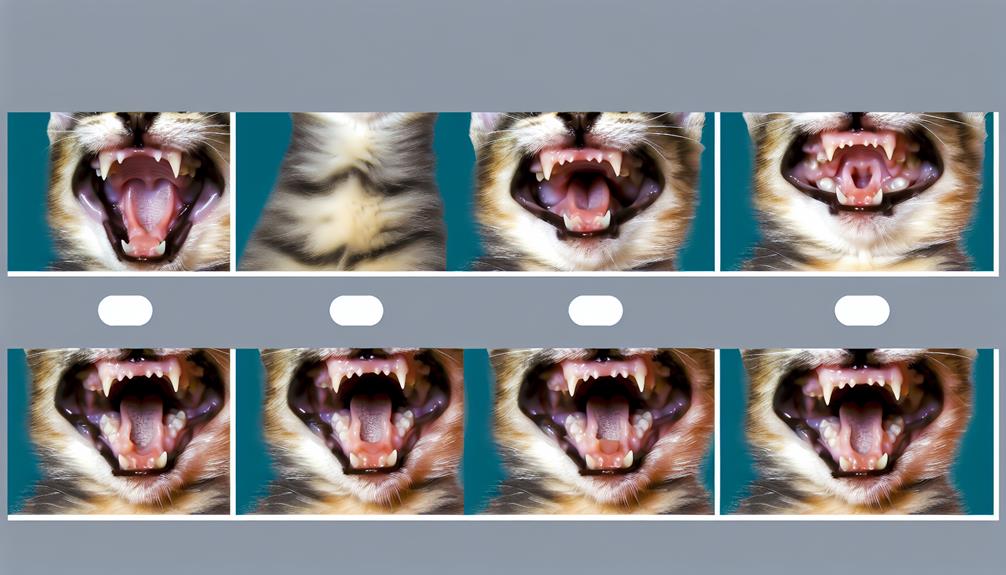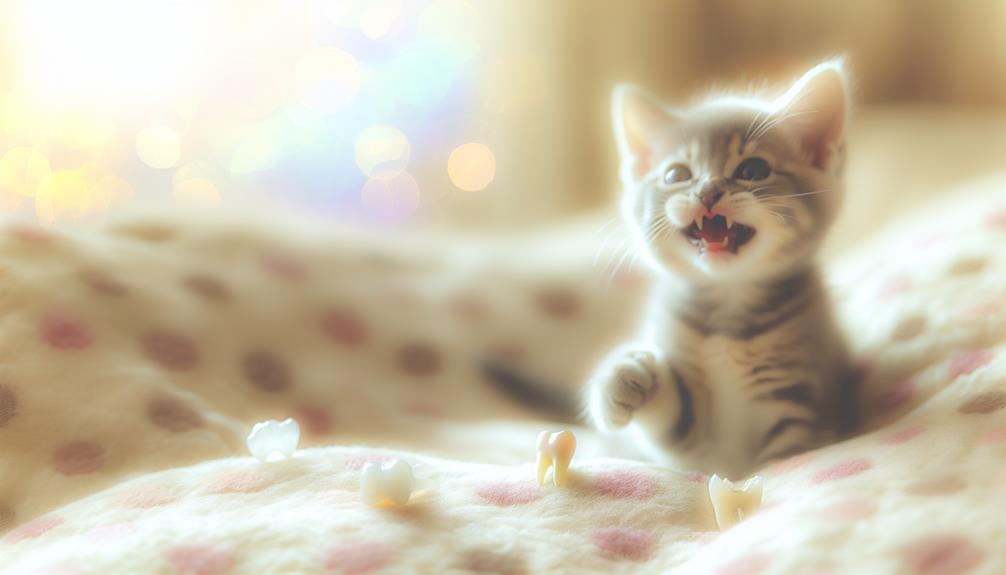You might wonder if your playful kitten's teething troubles mirror those of human infants. Indeed, cats do lose their baby teeth, typically starting around 3-4 months old. During this period, you'll notice increased chewing and perhaps some drooling as their 26 deciduous teeth make way for 30 adult teeth. But what exactly should you expect during this change, and how can you guarantee your kitten remains comfortable and healthy? There are several key signs and stages to be aware of, as well as common issues that could arise during teething.
Kitten Teething Timeline
Kittens, much like human infants, go through a teething process that is both fascinating and essential to their development. During the initial weeks of life, a kitten's dental growth is marked by the emergence of deciduous teeth, commonly known as baby teeth. This typically begins at around two to three weeks of age. By the time your kitten reaches six weeks, it should have a complete set of 26 deciduous teeth.
Understanding the timeline of kitten teething is critical in guaranteeing ideal dental health. Around the age of three to four months, the process of shedding these baby teeth begins, making way for the permanent teeth. By six to seven months, your kitten should have a full set of 30 adult teeth, which includes incisors, canines, premolars, and molars.
The shift from deciduous to permanent teeth is a critical period for dental growth. During this phase, you might notice some minor discomfort as the new teeth push through the gums, displacing the baby teeth. It's important to monitor this process closely to make sure that it proceeds without complications such as retained deciduous teeth, which can cause misalignment or dental crowding.
You'll need to provide appropriate dental care during this teething timeline. Items like teething toys can help alleviate discomfort and promote healthy chewing habits. Regular veterinary check-ups are also essential to monitor the dental growth and guarantee no abnormalities occur. By understanding and managing the kitten teething timeline, you're setting the stage for robust dental health that will benefit your feline friend throughout its life.
Signs of Teething in Kittens
During the teething phase, several distinct signs can indicate that your kitten is undergoing this vital developmental stage. One of the primary indicators is a noticeable increase in chewing behavior. You may observe your kitten gnawing on various objects more frequently, including furniture, shoes, and fingers. This chewing behavior serves as a mechanism to alleviate the discomfort associated with erupting teeth.
Another observable sign is increased salivation. The process of teeth breaking through the gums can stimulate salivary glands, resulting in drooling. Although this is a common response, it's essential to verify that excessive drooling isn't due to other medical conditions such as oral infections.
Changes in eating habits can also signify teething. Your kitten might display reluctance to eat dry kibble, showing a preference for softer foods that are easier to chew. This alteration in diet preference can be attributed to the tenderness of the gums during teething.
Behavioral changes are another hallmark. Kittens might become more irritable or restless due to the discomfort. You might also notice a tendency for your kitten to seek out teething toys, which provide a safe and effective way to manage the pain and satisfy the urge to chew.
Furthermore, occasional bleeding of the gums can occur as the new teeth push through the tissue. While minor bleeding is generally not a cause for concern, any substantial or prolonged bleeding should be evaluated by a veterinarian.
Stages of Tooth Development

Ever wondered how a kitten's teeth develop over time? The process begins with the tooth eruption of deciduous teeth, otherwise known as baby teeth. A kitten's dental anatomy comprises 26 deciduous teeth, which start to emerge at around two to four weeks of age. Typically, the incisors are the first to appear, followed by the canines, and finally, the premolars. This initial phase is vital as these teeth help the kitten shift from milk to solid food.
By the time the kitten reaches three to four months of age, the deciduous teeth begin to fall out, making way for the permanent teeth. This stage is characterized by the eruption of 30 adult teeth, composed of 12 incisors, four canines, 10 premolars, and four molars. The incisors, which are the smallest and most numerous, usually start to emerge first. The canines, which are longer and more pointed, follow shortly after. Premolars and molars, responsible for grinding food, are the last to appear.
Throughout these stages, the kitten's dental anatomy undergoes significant changes. The roots of the deciduous teeth are resorbed, allowing them to be shed without much discomfort. This natural progression guarantees that the new permanent teeth align correctly within the jaw. The entire process of tooth eruption and replacement is typically completed by the time the kitten is six to seven months old.
Understanding these stages is essential for monitoring your kitten's dental health. Regular check-ups with a veterinarian can help guarantee that the tooth eruption process is proceeding normally and that there are no complications.
Common Teething Issues
When it comes to teething, you might notice some common issues that can affect your kitten's comfort and health. During this developmental phase, kittens often experience gingivitis, excessive drooling, and a propensity to chew on various objects. Gingivitis, an inflammation of the gums, is frequently observed due to the erupting deciduous teeth causing irritation. You might see redness and swelling around the gum line, which can be quite uncomfortable for your kitten.
Excessive drooling is another prevalent issue, often resulting from the discomfort and pain associated with teething. The increased saliva production acts as a natural lubricant, helping to ease the passage of new teeth through the gums. However, persistent drooling can sometimes lead to secondary skin infections around the mouth if not properly managed.
Kittens also exhibit a heightened tendency to chew on objects during teething. This behavior is an instinctual response to alleviate gum discomfort. While chewing can be beneficial, it can also pose risks if your kitten gnaws on inappropriate or harmful items. Providing teething toys specifically designed for kittens can help mitigate this issue. These toys are typically made of materials that are safe and effective in reducing discomfort.
Another significant issue is the occasional retention of deciduous teeth, which can lead to malocclusion or misalignment of the permanent teeth. This condition necessitates veterinary intervention to prevent long-term dental problems.
To alleviate these common teething issues, various soothing techniques can be employed. Cold compresses or chilled teething toys can provide temporary relief by numbing the affected area, thereby reducing inflammation and pain. Monitoring your kitten closely during this period and addressing any persistent or severe symptoms with veterinary care guarantees ideal dental health and comfort.
Caring for Teething Kittens

Although teething can be a challenging period for kittens, implementing specific care strategies can greatly ease their discomfort and support their dental development. During this phase, kittens often experience sore gums and may exhibit increased chewing behavior. By providing appropriate teething toys and employing effective soothing methods, you can help mitigate these symptoms and promote healthy oral maturation.
Teething toys are vital for alleviating gum discomfort. Choose toys made from soft, pliable materials that are safe to chew. These toys not only divert your kitten's attention away from inappropriate objects but also help massage their gums, reducing pain. Below is a concise table outlining preferred teething toys and their benefits:
| Teething Toy Type | Benefits |
|---|---|
| Soft Rubber Chew Toys | Gentle on gums, easy to clean |
| Fabric Teething Rings | Textured, provides varied chewing surfaces |
| Silicone Teething Sticks | Durable, can be chilled for extra relief |
In addition to teething toys, soothing methods play an important role. Cooling your kitten's gums can provide notable relief. You can achieve this by chilling teething toys or offering a cold, damp washcloth for them to chew on. This reduces inflammation and numbs the pain temporarily. Another effective method is gently massaging their gums with a clean finger, which can enhance blood flow and reduce soreness.
Employing these strategies guarantees a smoother teething process for your kitten. By carefully selecting teething toys and using proven soothing methods, you contribute greatly to their dental health and overall well-being. Remember, attentive care during teething sets the foundation for strong, healthy adult teeth.
Maintaining Dental Health
To guarantee your cat's dental health, you should prioritize regular dental checkups with a veterinary professional. Implementing proper oral hygiene practices, such as brushing your cat's teeth with feline-safe toothpaste, is essential. These steps can prevent periodontal disease and other oral health issues, promoting overall well-being.
Regular Dental Checkups
Regular dental checkups are essential for maintaining your cat's dental health and overall well-being. The importance of dental checkups cannot be overstated, as they help identify potential issues before they become severe. Cats are prone to dental diseases such as periodontal disease, gingivitis, and tooth resorption, which can lead to pain and systemic health problems if left untreated.
The recommended frequency of vet visits for dental checkups is at least once a year, though senior cats or those with pre-existing dental conditions may require more frequent monitoring. During these visits, your veterinarian will perform a thorough oral examination, possibly including dental radiographs to assess the health of your cat's teeth and gums.
Key Benefits of Regular Dental Checkups:
- Early Detection: Identifying dental diseases early allows for timely intervention, minimizing discomfort and preventing complications.
- Professional Cleaning: Veterinarians can perform professional cleanings that remove plaque and tartar build-up, which are not easily addressed by home care.
- Expert Advice: Your vet can provide tailored recommendations for maintaining your cat's oral health, including dietary advice and preventive measures.
- Overall Health Monitoring: Dental issues can be indicative of broader health concerns, making these checkups critical for your cat's overall health.
Regular dental checkups play an important role in ensuring your cat's long-term health and comfort.
Proper Oral Hygiene
Maintaining proper oral hygiene is vital for preventing dental diseases and guaranteeing your cat's overall health. Regular tooth brushing is the cornerstone of effective oral care. Utilize a toothbrush designed specifically for cats, coupled with feline-safe toothpaste. Aim to brush your cat's teeth at least two to three times weekly to prevent plaque accumulation and tartar formation, which can lead to periodontal disease.
In addition to tooth brushing, incorporating dental treats into your cat's diet can greatly enhance their oral hygiene. These treats are formulated to reduce plaque and tartar through mechanical action as your cat chews. Choose dental treats that are approved by veterinary dental associations to confirm their efficacy and safety.
Furthermore, consider using oral rinses or water additives designed for cats. These products can help reduce bacterial load in the oral cavity, contributing to fresher breath and healthier gums.
Monitoring your cat's oral hygiene is essential. Look out for signs of dental issues such as bad breath, drooling, or difficulty eating. Early detection and intervention can prevent more severe health complications. By maintaining a diligent oral hygiene routine, you're not just preserving your cat's teeth but also promoting their overall well-being.
Conclusion
In summary, maneuvering your kitten's teething journey is akin to steering through a tempestuous sea of dental upheaval. You'll witness a veritable storm of chewing, drooling, and occasional discomfort as those 26 deciduous teeth make way for 30 robust adult teeth. By vigilantly monitoring and providing appropriate care, you guarantee their dental fortress remains impenetrable. Remember, this fleeting phase is but a small price for a lifetime of impeccable feline dental health. Sail on, intrepid kitten caretaker!
